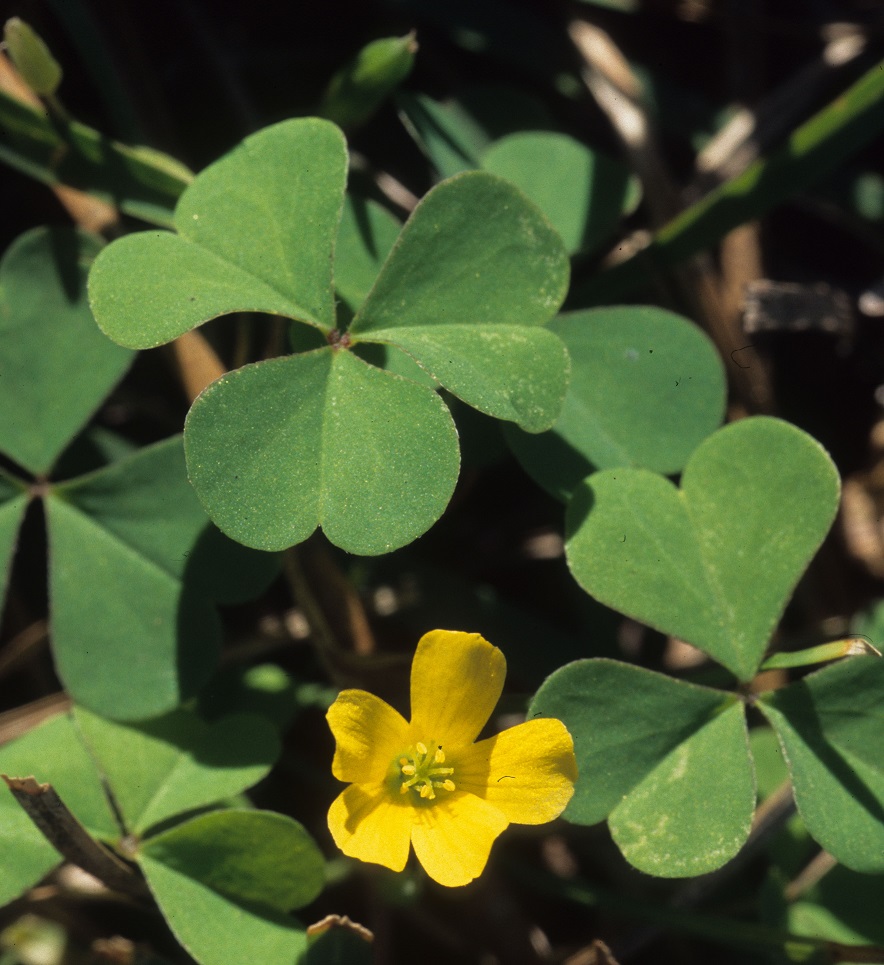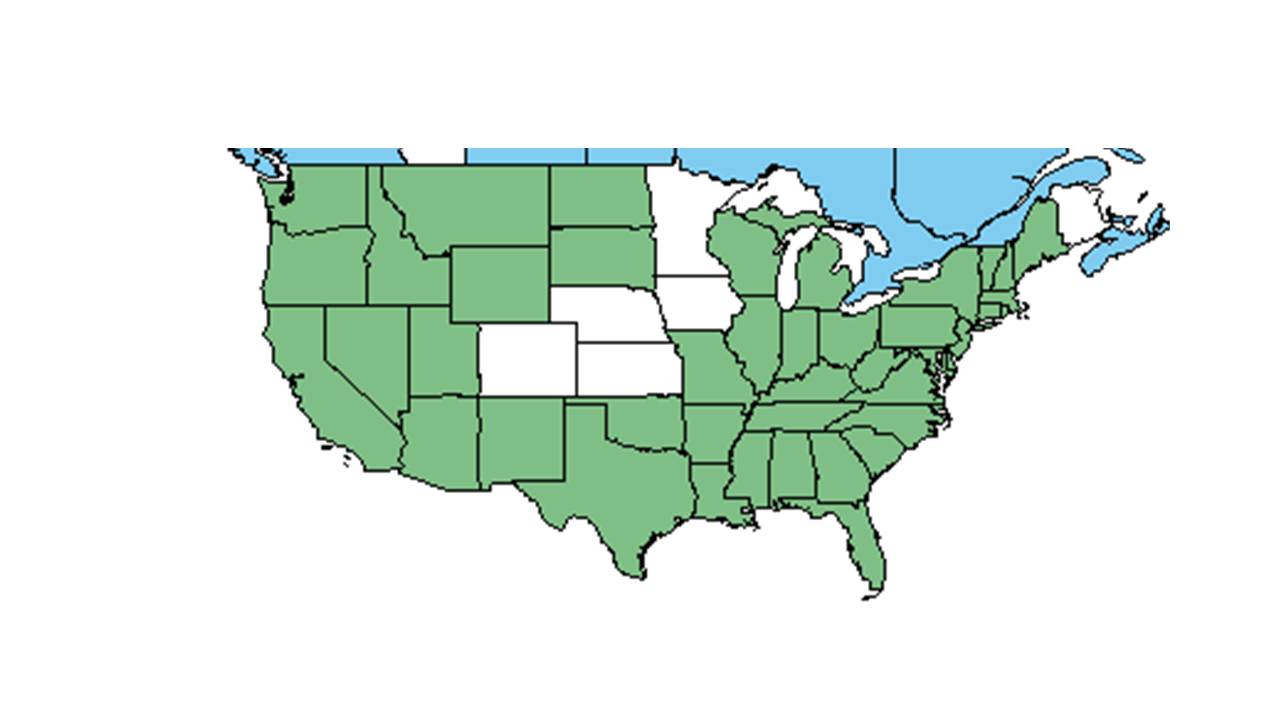Difference between revisions of "Oxalis corniculata"
(→Conservation and Management) |
Krobertson (talk | contribs) |
||
| Line 24: | Line 24: | ||
==Description== | ==Description== | ||
<!-- Basic life history facts such as annual/perrenial, monoecious/dioecious, root morphology, seed type, etc. --> | <!-- Basic life history facts such as annual/perrenial, monoecious/dioecious, root morphology, seed type, etc. --> | ||
| − | "Caulescent or acaulescent, herbaceous perennials with rhizomes or bulbs, or annuls with fibrous roots. Leaves alternate, ternately compound, leaflets 3, obcordate; stipules very small or obsolete. Flowers in pedunculate umbels or cymes, or solitary. Sepals 5; petals 5 separate or adnate to each other just above the base; stamens 1-, of 2 lengths. Pistil with 5 carpels. Capsule longitudinally dehiscent. Seeds red, prominently reticulate, pitted or smooth, each completely enclosed by an elastically dehiscent, transparent aril that aids in its distribution. Heterostyly is typical of plants in this genus. " | + | "Caulescent or acaulescent, herbaceous perennials with rhizomes or bulbs, or annuls with fibrous roots. Leaves alternate, ternately compound, leaflets 3, obcordate; stipules very small or obsolete. Flowers in pedunculate umbels or cymes, or solitary. Sepals 5; petals 5 separate or adnate to each other just above the base; stamens 1-, of 2 lengths. Pistil with 5 carpels. Capsule longitudinally dehiscent. Seeds red, prominently reticulate, pitted or smooth, each completely enclosed by an elastically dehiscent, transparent aril that aids in its distribution. Heterostyly is typical of plants in this genus. " <ref name="Radford et al 1964">Radford, Albert E., Harry E. Ahles, and C. Ritchie Bell. Manual of the Vascular Flora of the Carolinas. 1964, 1968. The University of North Carolina Press. 646-8. Print.</ref> |
| − | "Caulescent, stoloniferous herb with fibrous roots. Stolons completely prostrate, usually bearing roots at each node, and usually flowering from the axils of leaves from rooted nodes. Stems, petioles, and peduncles, slightly pilose. Leaflets green, reddish or purplish, ca. 2 cm long or often considerable less. Peduncles mostly shorter than the subtending petioles, mostly 1-or 2-flowered. Sepals not gland-tipped; petals yellow, 5-7 mm long. Capsule prismatic, 0.8-1 cm long, sparsely pubescent. Seeds reticulate." | + | "Caulescent, stoloniferous herb with fibrous roots. Stolons completely prostrate, usually bearing roots at each node, and usually flowering from the axils of leaves from rooted nodes. Stems, petioles, and peduncles, slightly pilose. Leaflets green, reddish or purplish, ca. 2 cm long or often considerable less. Peduncles mostly shorter than the subtending petioles, mostly 1-or 2-flowered. Sepals not gland-tipped; petals yellow, 5-7 mm long. Capsule prismatic, 0.8-1 cm long, sparsely pubescent. Seeds reticulate." <ref name="Radford et al 1964"/> |
==Distribution== | ==Distribution== | ||
==Ecology== | ==Ecology== | ||
===Habitat=== <!--Natural communities, human disturbed habitats, topography, hydrology, soils, light, fire regime requirements for removal of competition, etc.--> | ===Habitat=== <!--Natural communities, human disturbed habitats, topography, hydrology, soils, light, fire regime requirements for removal of competition, etc.--> | ||
| − | ''O. corniculata'' occurs in moist to dry sandy or loamy soils | + | ''O. corniculata'' occurs in moist to dry sandy or loamy soils. <ref name="FSU Herbarium">Florida State University Robert K. Godfrey Herbarium database. URL: [http://herbarium.bio.fsu.edu http://herbarium.bio.fsu.edu]. Last accessed: June 2014. Collectors: Loran C. Anderson, Bian Tan, J. M. Kane, Robert K. Godfrey, and Andre F. Clewell. States and Counties: Florida: Alachua, Franklin, Leon, and Washington. Georgia: Grady and Thomas.</ref> It can be found in lowland woodlands, as well as disturbed sites, including along trails, mowed lawns, and near man-made ponds. <ref name="FSU Herbarium"/> |
===Phenology=== <!--Timing off flowering, fruiting, seed dispersal, and environmental triggers. Cite PanFlora website if appropriate: http://www.gilnelson.com/PanFlora/ --> | ===Phenology=== <!--Timing off flowering, fruiting, seed dispersal, and environmental triggers. Cite PanFlora website if appropriate: http://www.gilnelson.com/PanFlora/ --> | ||
| − | Flowering has been observed in August and October | + | Flowering has been observed in August and October. <ref name="FSU Herbarium"/> |
<!--===Seed dispersal===--> | <!--===Seed dispersal===--> | ||
<!--===Seed bank and germination===--> | <!--===Seed bank and germination===--> | ||
| Line 50: | Line 50: | ||
==References and notes== | ==References and notes== | ||
| − | |||
| − | |||
| − | |||
Revision as of 18:30, 3 August 2016
| Oxalis corniculata | |
|---|---|

| |
| Photo taken by Gil Nelson | |
| Scientific classification | |
| Kingdom: | Plantae |
| Division: | Magnoliophyta - Flowering plants |
| Class: | Magnoliopsida – Dicotyledons |
| Order: | Geraniales |
| Family: | Oxalidaceae |
| Genus: | Oxalis |
| Species: | O. corniculata |
| Binomial name | |
| Oxalis corniculata L. | |

| |
| Natural range of Oxalis corniculata from USDA NRCS Plants Database. | |
Common name: creeping woodsorrel
Contents
Taxonomic notes
Synonyms: Oxalis repens Thunberg; Xanthoxalis corniculata (Linnaeus) Small; Xanthoxalis langloisii Small; O. corniculata var. corniculata; O. corniculata var. atropurpurea Planchon
Description
"Caulescent or acaulescent, herbaceous perennials with rhizomes or bulbs, or annuls with fibrous roots. Leaves alternate, ternately compound, leaflets 3, obcordate; stipules very small or obsolete. Flowers in pedunculate umbels or cymes, or solitary. Sepals 5; petals 5 separate or adnate to each other just above the base; stamens 1-, of 2 lengths. Pistil with 5 carpels. Capsule longitudinally dehiscent. Seeds red, prominently reticulate, pitted or smooth, each completely enclosed by an elastically dehiscent, transparent aril that aids in its distribution. Heterostyly is typical of plants in this genus. " [1]
"Caulescent, stoloniferous herb with fibrous roots. Stolons completely prostrate, usually bearing roots at each node, and usually flowering from the axils of leaves from rooted nodes. Stems, petioles, and peduncles, slightly pilose. Leaflets green, reddish or purplish, ca. 2 cm long or often considerable less. Peduncles mostly shorter than the subtending petioles, mostly 1-or 2-flowered. Sepals not gland-tipped; petals yellow, 5-7 mm long. Capsule prismatic, 0.8-1 cm long, sparsely pubescent. Seeds reticulate." [1]
Distribution
Ecology
Habitat
O. corniculata occurs in moist to dry sandy or loamy soils. [2] It can be found in lowland woodlands, as well as disturbed sites, including along trails, mowed lawns, and near man-made ponds. [2]
Phenology
Flowering has been observed in August and October. [2]
Conservation and management
Cultivation and restoration
Photo Gallery
References and notes
- ↑ 1.0 1.1 Radford, Albert E., Harry E. Ahles, and C. Ritchie Bell. Manual of the Vascular Flora of the Carolinas. 1964, 1968. The University of North Carolina Press. 646-8. Print.
- ↑ 2.0 2.1 2.2 Florida State University Robert K. Godfrey Herbarium database. URL: http://herbarium.bio.fsu.edu. Last accessed: June 2014. Collectors: Loran C. Anderson, Bian Tan, J. M. Kane, Robert K. Godfrey, and Andre F. Clewell. States and Counties: Florida: Alachua, Franklin, Leon, and Washington. Georgia: Grady and Thomas.